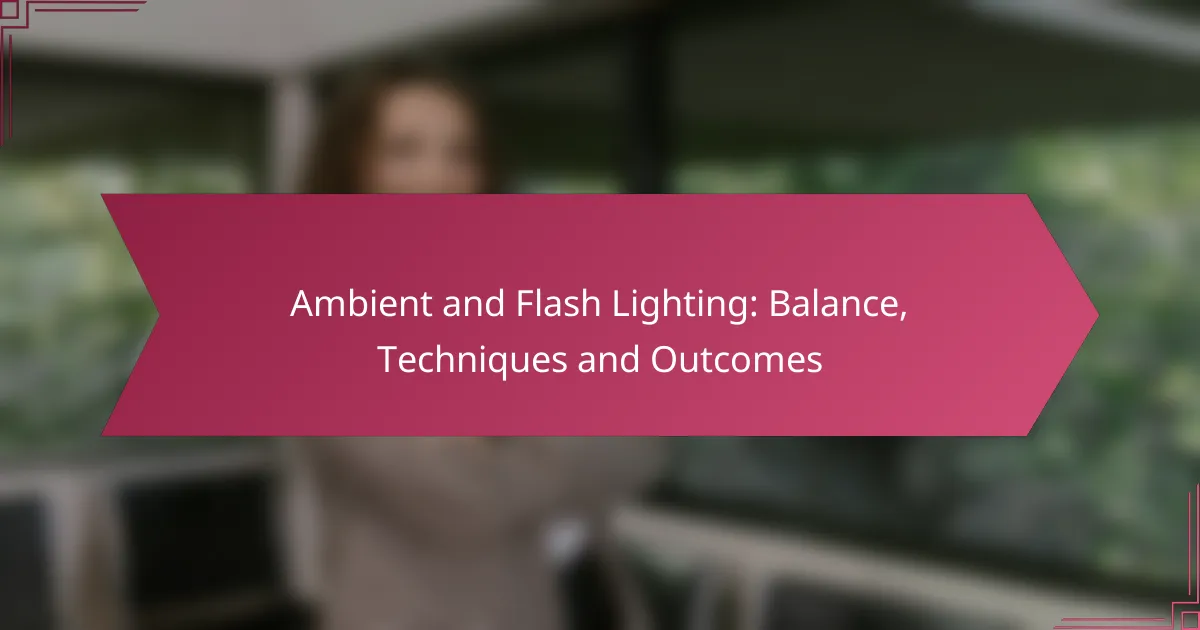Balancing ambient and flash lighting is essential for creating cohesive and visually appealing images. By harmonizing the intensity and quality of both light sources, photographers can enhance their subjects while maintaining a natural appearance. Mastering techniques such as layering, diffusion, and color gels allows for greater artistic expression and improved viewer engagement.
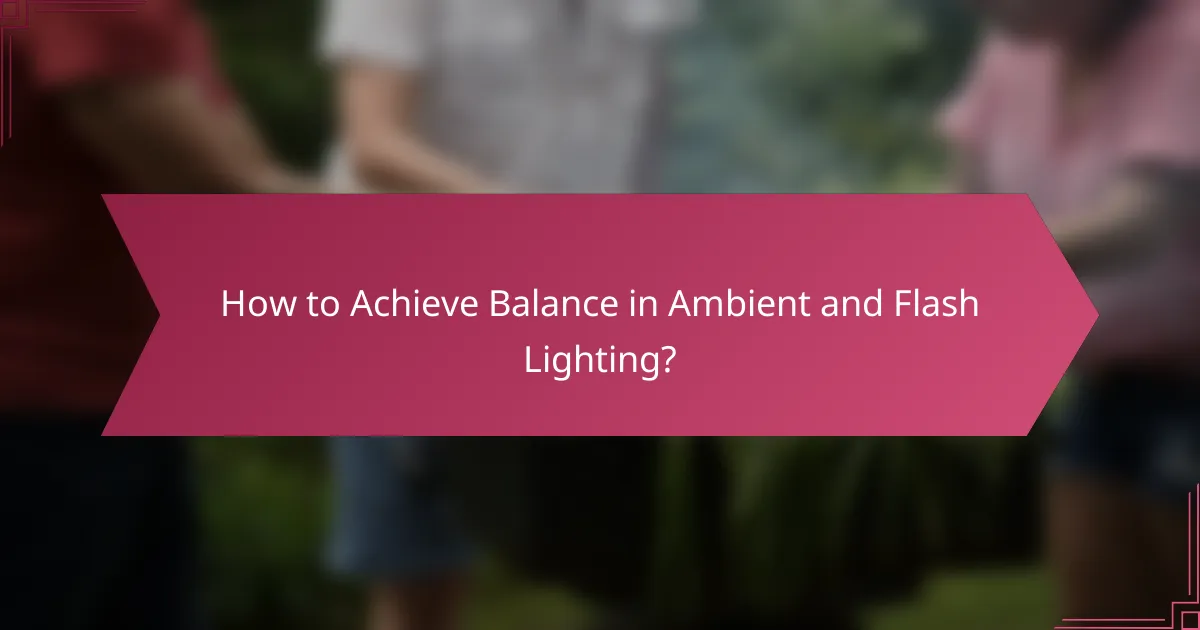
How to Achieve Balance in Ambient and Flash Lighting?
Achieving balance in ambient and flash lighting involves harmonizing the intensity and quality of both light sources to create a cohesive image. This balance enhances the subject while maintaining a natural look, ensuring that neither light source overwhelms the other.
Understanding light ratios
Light ratios refer to the relationship between ambient light and flash light in a scene. A common starting point is a 2:1 ratio, where ambient light is twice as strong as the flash. Adjusting this ratio can dramatically change the mood and depth of your photographs.
For example, a higher ambient light ratio can create a softer, more natural look, while a lower ratio can produce a dramatic effect with more pronounced shadows. Experimenting with different ratios helps you find the right balance for your specific situation.
Using reflectors for balance
Reflectors can effectively balance ambient and flash lighting by redirecting light onto the subject. They come in various colors, such as white for softening shadows and silver for increasing brightness. Positioning a reflector opposite the flash can fill in shadows created by the flash, creating a more even light distribution.
When using reflectors, consider their size and distance from the subject. Larger reflectors provide broader light coverage, while smaller ones can create focused highlights. Adjusting the angle of the reflector can also help control the intensity of the reflected light.
Adjusting flash power
Adjusting the power of your flash is crucial for achieving balance with ambient light. Most flashes allow for power adjustments, typically ranging from full power to fractions like 1/2, 1/4, or even lower. Reducing flash power can help prevent overexposure and maintain the natural look of the ambient light.
As a rule of thumb, start with a lower flash power and gradually increase it until you achieve the desired effect. This approach helps you avoid overpowering the ambient light and ensures a more harmonious blend.
Positioning ambient light sources
The positioning of ambient light sources plays a significant role in achieving balance. Natural light, such as sunlight or window light, should be considered when setting up your shot. Position your subject in a way that utilizes this light effectively, ensuring it complements the flash rather than competes with it.
For indoor settings, consider the direction and intensity of artificial light sources. Adjusting their position or using dimmers can help create a more balanced lighting environment, allowing for a seamless integration of flash and ambient light.
Evaluating lighting conditions
Before shooting, evaluate the overall lighting conditions to determine how ambient and flash lighting will interact. Factors such as time of day, weather, and indoor lighting can significantly affect your setup. Take test shots to assess how the light sources work together and make adjustments as needed.
Pay attention to the color temperature of both light sources, as mismatched temperatures can lead to unnatural results. Using gels on your flash can help match the ambient light’s color temperature, ensuring a more cohesive look in your images.
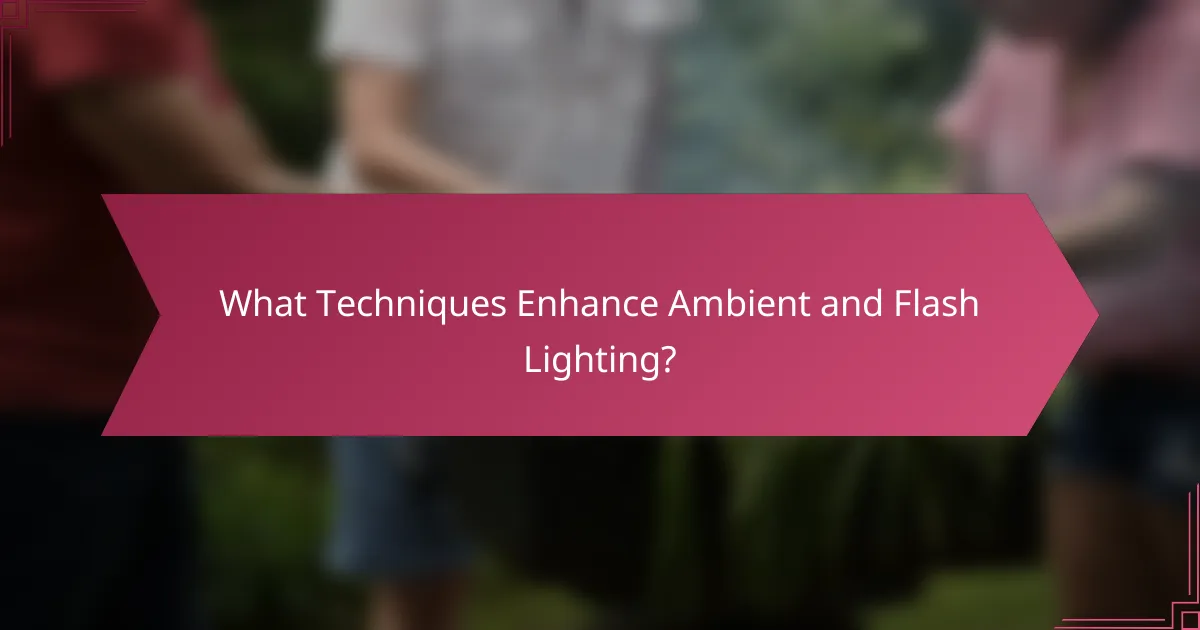
What Techniques Enhance Ambient and Flash Lighting?
Enhancing ambient and flash lighting involves techniques that create a balanced and harmonious lighting environment. Key methods include layering light sources, utilizing diffusers, employing bounce techniques, and incorporating color gels to achieve desired effects.
Layering light sources
Layering light sources involves using multiple types of lighting to create depth and dimension in a scene. For instance, combining ambient light with key and fill lights can help achieve a more balanced exposure. Consider using a mix of natural light and artificial sources to enhance the overall atmosphere.
When layering, pay attention to the intensity and color temperature of each light source. A common approach is to start with a base layer of ambient light, then add focused lighting to highlight subjects or areas of interest. This technique can help avoid harsh shadows and create a more inviting space.
Utilizing diffusers
Diffusers soften and spread light, reducing harsh shadows and creating a more flattering illumination. They can be made from various materials, such as fabric or plastic, and can be placed in front of flash units or other light sources. Using a diffuser can significantly improve the quality of light in portraits or product photography.
When selecting a diffuser, consider its size and opacity. Larger diffusers create softer light, while smaller ones may still produce some harshness. Experiment with different distances between the diffuser and the subject to find the ideal balance for your specific lighting scenario.
Employing bounce techniques
Bouncing light off surfaces, such as walls or ceilings, can create a more natural and even illumination. This technique helps to diffuse the light and minimize direct harshness, making it ideal for indoor photography. Use white or light-colored surfaces for the best results, as they reflect light effectively.
To employ bounce techniques, position your flash or light source at an angle that allows the light to hit the bounce surface before reaching the subject. This can create a soft, ambient effect while maintaining the necessary exposure. Be mindful of the color of the surface, as it can influence the overall tone of the light.
Incorporating color gels
Color gels are filters placed over light sources to alter their color temperature or create specific hues. This technique can enhance mood and atmosphere in photography or videography by adding warmth or coolness to the lighting. Common applications include using orange gels to simulate sunset or blue gels for a cooler ambiance.
When using color gels, consider the overall color balance of your scene. It’s essential to match the gel color with the ambient light to avoid unnatural color casts. Experiment with different gel combinations to achieve creative effects while maintaining a cohesive look in your images.
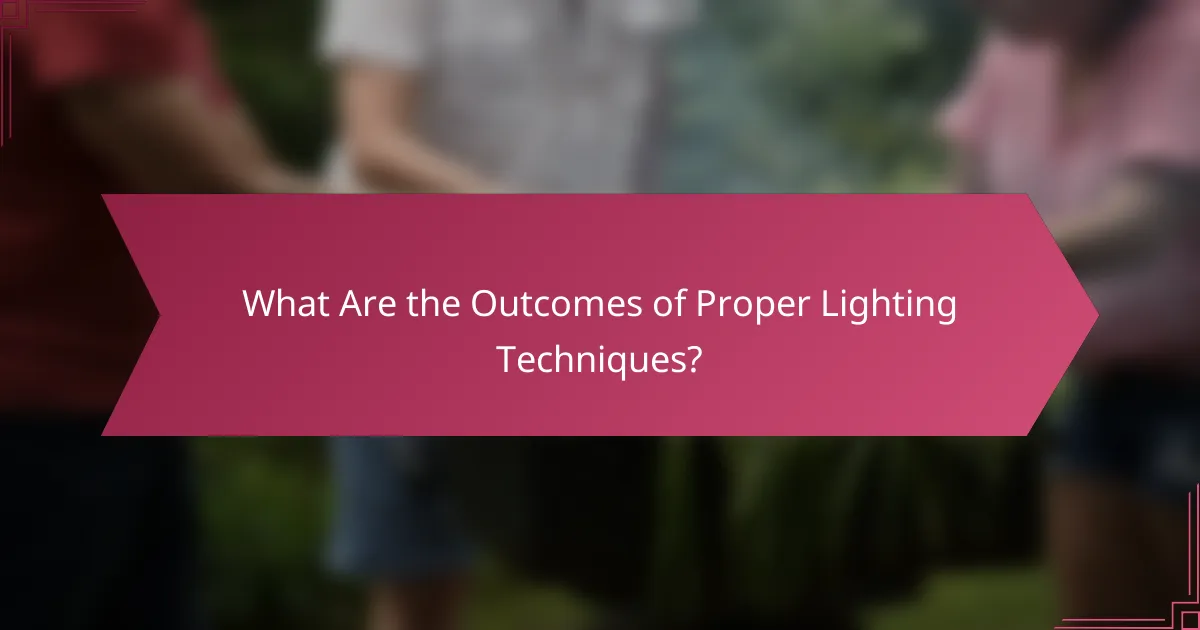
What Are the Outcomes of Proper Lighting Techniques?
Proper lighting techniques lead to significant improvements in visual media, enhancing clarity, mood, and viewer interaction. By mastering ambient and flash lighting, photographers and videographers can achieve desired artistic effects and convey messages more effectively.
Improved image quality
Effective lighting techniques directly enhance image quality by ensuring that subjects are well-lit and colors are accurately represented. Properly balanced ambient and flash lighting can reduce unwanted shadows and highlights, resulting in clearer and more vibrant images.
For instance, using softboxes or diffusers can help create even lighting, minimizing harsh contrasts. This is particularly important in portrait photography, where skin tones need to appear natural and flattering.
Enhanced mood and atmosphere
Lighting plays a crucial role in setting the mood and atmosphere of a scene. Different lighting techniques can evoke various emotions; for example, warm tones can create a cozy and inviting feel, while cooler tones may convey a sense of calm or detachment.
In film and video production, using colored gels or adjusting the intensity of lights can dramatically alter the viewer’s perception and emotional response. Consider experimenting with different light temperatures to see how they affect the overall ambiance of your work.
Greater subject focus
Proper lighting techniques help draw attention to the main subject by creating contrast with the background. By using techniques like spotlighting or backlighting, you can emphasize the subject while minimizing distractions from the surroundings.
For example, in product photography, a focused light source can highlight the product’s features, making it more appealing to potential buyers. Always consider the placement and intensity of your lights to achieve the desired focus.
Increased viewer engagement
Well-executed lighting can significantly boost viewer engagement by creating visually compelling content. When images or videos are aesthetically pleasing and easy to interpret, viewers are more likely to connect with the material and share it with others.
To enhance engagement, consider using dynamic lighting techniques, such as changing light patterns or incorporating movement. This not only captivates the audience but also encourages them to spend more time interacting with your content.
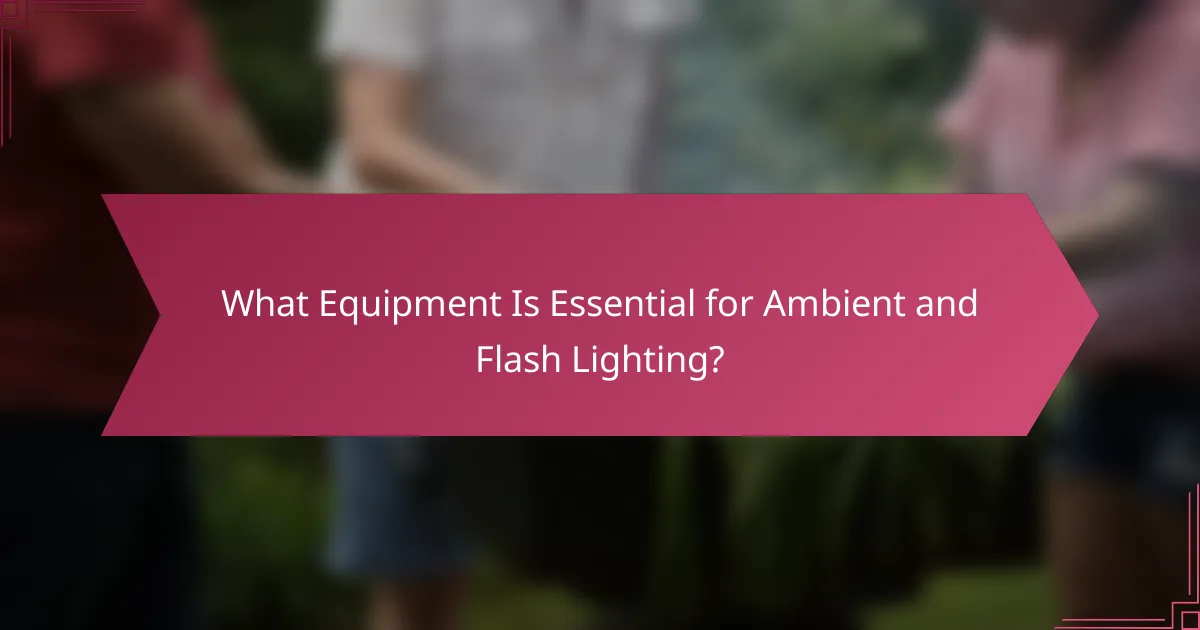
What Equipment Is Essential for Ambient and Flash Lighting?
Essential equipment for ambient and flash lighting includes various types of flash units and ambient light sources. Choosing the right combination can significantly enhance your photography by balancing natural and artificial light effectively.
Types of flash units
Flash units come in several types, including speedlights, studio strobes, and ring flashes. Speedlights are compact and versatile, making them ideal for on-the-go photography, while studio strobes offer higher power and are suited for controlled environments.
When selecting a flash unit, consider its guide number, recycle time, and compatibility with your camera system. For instance, a speedlight with a guide number of around 60 can provide ample light for most indoor settings, while studio strobes often exceed this, offering more flexibility in larger spaces.
Recommended ambient light sources
Ambient light sources include natural light, LED panels, and softboxes. Natural light is often the most flattering and can be enhanced with reflectors to fill shadows. LED panels provide consistent lighting and are adjustable, making them suitable for various shooting conditions.
Softboxes diffuse light, creating a softer appearance that reduces harsh shadows. When choosing ambient light sources, consider their color temperature and power output to ensure they complement your flash units effectively, typically aiming for a balance around 5500K for daylight conditions.
